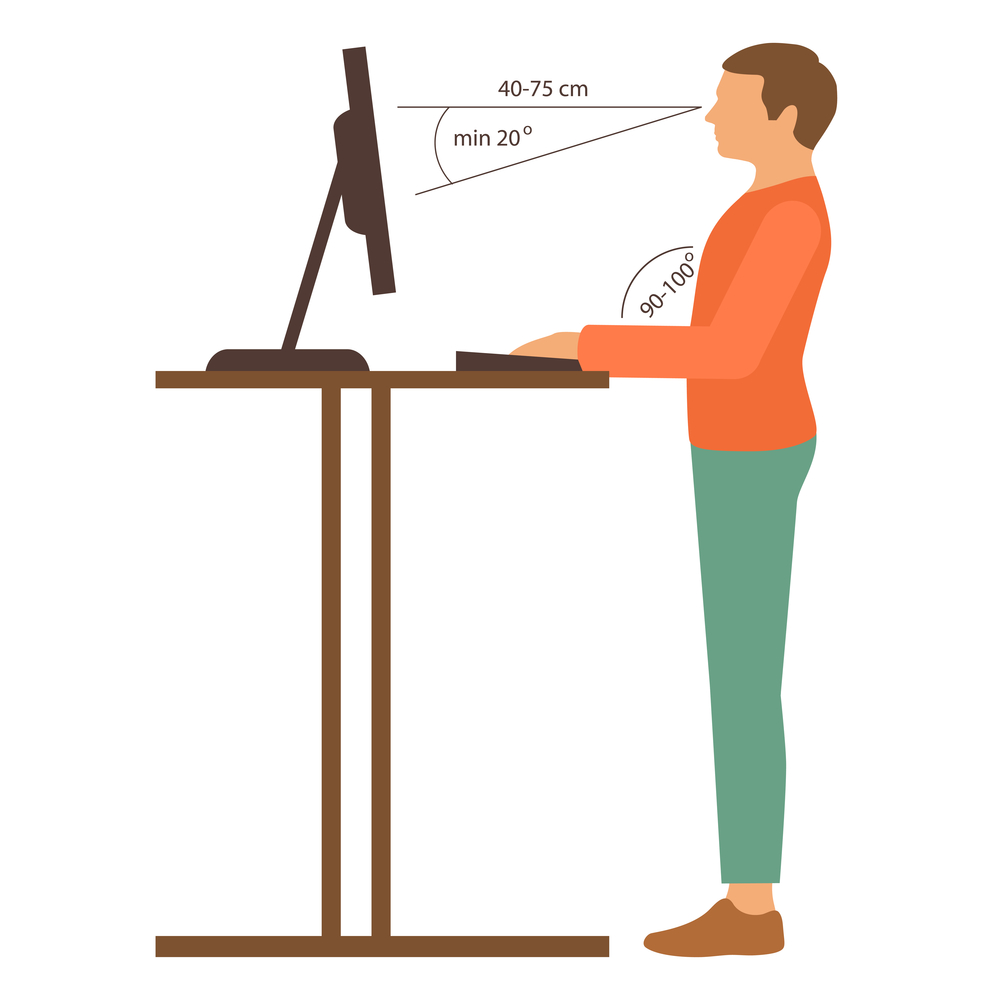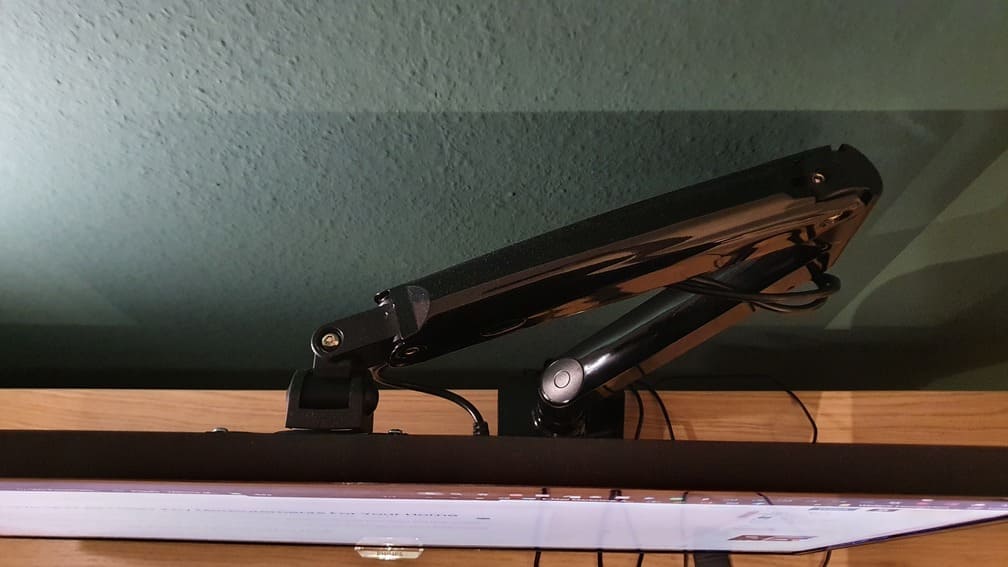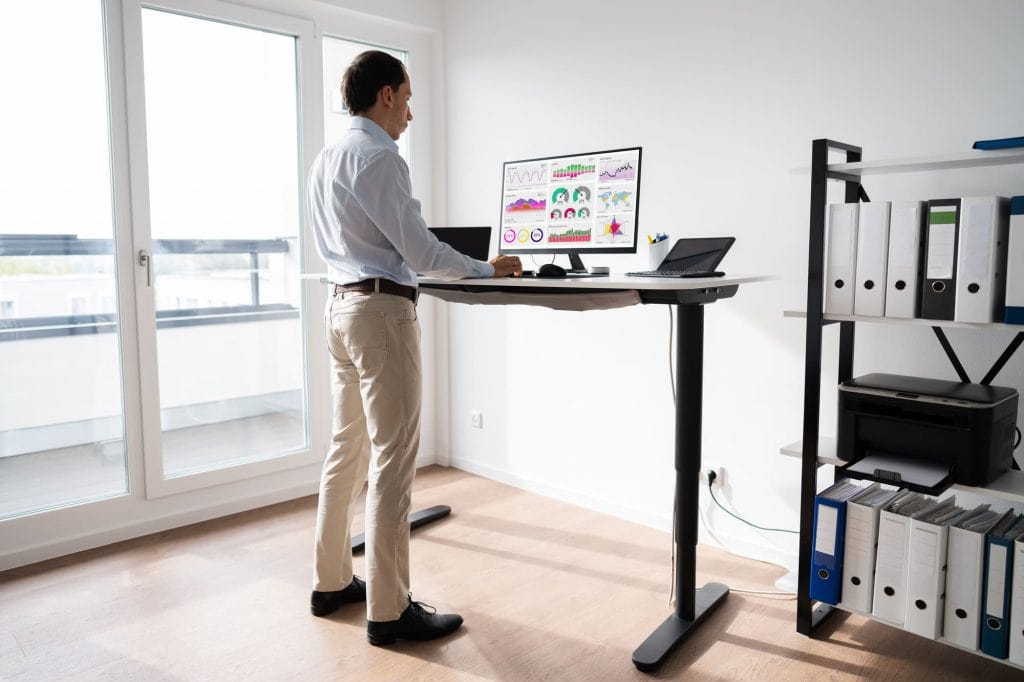*When you buy through links on our site, we may earn an affiliate commission at no additional cost to you.
A desk that’s set too high automatically compromises your comfort. When you’re not comfortable in your workspace, you find it hard to concentrate, and your productivity goes south fast.
If you try using a too-high desk, you’ll be forced to sit or stand incorrectly to compensate for the incorrect desk height. This will subtly contort your body parts uncomfortably—including the neck, shoulders writs, arms, bag, and legs.
In extreme cases, the wrong desk height can cause irreversible spinal disc and back damage!
The following guide looks at the improper desk height and how it affects your workspace productivity and even health in the long run. You’ll discover what the right desk height is and what to do if your desk is too high.
Table of Contents
What happens when the sit-stand desk is too high?
Working on a desk that’s too high is bad for you. It is more like punishing yourself by pushing your system beyond limits, and this is sure to cause a range of issues related to the body working too hard.

Below, we look at the effects of prolonged periods at a desk with improper height…
Shoulder scrunch
When you use a desk too high for you, you’ll be forced to overwork your shoulders and arm muscles. Your shoulders will be forced into a contracted position, which can cause problems with your health with time.
This is what happens: your shoulder muscles will be in a contracted manner all day long, and over time, they tend to ride up by your ears and stay in that position indefinitely.
This posture is usually referred to as the “office worker’s shoulder scrunch.” And it will soon turn into a habit without you being aware of it, and it will cause upper back, neck, and shoulder pain.
Neck pain
Using a desk that’s too high can also cause neck pains. With the desk being tall, you’ll be forced to work with your neck in an extension manner (i.e., head back) as you attempt to see your monitor screen.
This will create tension and even pain at the back of your head and neck. In some cases, this bad posture may also lead to neck cricks.
Muscle tension
Something else that will happen if you use a too-high desk is that your muscles will feel tense, and your joints will undergo a lot of stress.

This happens when you start moving your arms and hands when shifting between various activities at your desk, e.g., typing or maneuvering the mouse.
These activities will put your limbs in unnatural positions, creating stress in your joints and tension in your muscles.
After a long day at a high-height desk, you’ll deal with pains and aches.
Trips to your medical doctor will be inevitable
Overall staying in a standing position for an improperly adjusted standing desk will be taking your body on a path that will negatively impact your health.
After weeks or months at your desk, the pain will become unbearable one day. You’ll be left with no other option but to seek professional medical advice.
Don’t be surprised if your doctor suggests exercises or even physical therapy to help offset the impact. Though this might not be enough, depending on your specific condition.
What happens when the desk is too low?
Since we’re talking about improper desk height, we should address the issue of a desk height that’s too low. Yes, that can also be a source of problems for you.
If your desk surface is too low, you’ll be forced to hold your arms out most of the time to reach the keyboard. Doing this repeatedly will create static tension in your arm muscles. And this can ultimately cause pain and poor posture.
Using a desk with a lower height will also likely result in slumping. Picture yourself typing on a keyboard placed on a desktop that lies below your elbows. Isn’t it impossible to type on it without doing some slumping?
Unfortunately, this leaning will significantly impact your body parts, especially when you do it for extended periods.
To be more precise, it will create muscle tension and weakness around your upper back, shoulder, and neck. Plus, it may also result in a sunken chest.
How high should your desk height be?
There’s no universal height for office desks. The perfect height for a standard desk will vary from individual to individual, depending on your height.

Your desktop equipment and the kind of activities you do at the desk will also influence the perfect height for your desk.
When looking at how high your desk should be, we should look at the standard desks and the standing ones.
Best height for standard office desks
Standard office desks are around 28-30 inches high. This is the correct height designed with average height users (between 5’8″ and 5’10″) in mind.
However, people have varying heights. Some are taller, while others are vertically challenged, so not everyone will comfortably fit in a 28—inch desk.
The most important thing to remember when your desk is to maintain around 70 to 135-degree angle with your forearm.
To avoid pain and discomfort with long sitting hours, follow the following guidelines on how to correctly sit at your desk:
Step 1. Sit in your chair with your buttocks positioned all the way back. A good ergonomic office chair should have good back support to support your lower back while maintaining your spine’s natural arch.
Step 2. Ensure your elbows remain parallel to the floor by maintaining them at 90 degrees. Make sure your upper arms and hands rest comfortably on the desk surface to reach the keyboard or mouse without straining the elbows.
Step 3. Make use of your chair armrests. Most ergonomic chairs have adjustable arms which play an important role in your posture and support your shoulders to help keep you from slumping forward.
Whenever you rest your forearms on the armrests, you should feel your shoulders raise to minimize strain on your neck and shoulders.
Step 4. Extend your knees slightly off your chair edge. You can check if you’re doing it right by trying to slide your fingers beneath the thigh at the front end. If it feels too tight or you can fit more than just your fingers, you need to adjust it to the chair or desk or both.
Step 5. Sit in your chair all the way back with your feet flat on the floor. As for your lower legs, you should position them such that you can’t pass your fist between your calves and the front of your chair.
If the fist passes through, consider getting a chair with a shorter seat or add some cushion to the back of the existing chair.
Step 6. Once you’re all set and you feel comfortable in your chair, it’s now time to customize your monitor position.
Ideally, you want to position the screen so that your eyes settle at the center and you don’t tilt your head at all when you look at it.
If your monitor has limited travel or has a fixed height, you can try rising it with the help of a riser or a monitor arm.
Adjustable ergonomic desks will be preferable as they let you raise/lower them to a comfortable height.
TIP: You can even use a desk height calculator to help you easily decide the perfect height to set your desk and save yourself a lot of pain. There are multiple free online calculators for you to use. We suggest using this online calculator from Desky, one of the top manufacturers of height-adjustable ergonomic desks, to easily determine the ideal height to set your table at.
Nonetheless, if you’re using a fixed-height office desk, you can still make some changes or enhancements to enable it to comfortably accommodate you (more details come up later).
Best height for standing desks
Setting it to a comfortable height is much easier if you’re using a standing workstation, thanks to their adjustability feature.
However, beginners still miss how to set the standing desk height correctly. They end up using it with improper height and experiencing the discomfort we discussed earlier.
Ideally, your stand-up desk height should be at your elbow level. This is the height from the floor to the bottom of your elbow (with the elbows resting at around 90 degrees angle from the floor).

Many guides say that average height folks (5’11”) should set the desk at 44 inches. While this is true, it is mostly a guideline, so you shouldn’t blindly follow it. Instead, you’d want to examine your body proportions to ensure you correctly set the desk height.
To ensure you set your standing desk height correctly, follow the quick guidelines below:
Step 1. Stand up tall in front of your desk, with your shoulders pulled back the head parallel to the ceiling
Step 2. Now bend your elbows to around 90 degrees while you keep the arms by your sides
Step 3. Adjust the desk height to a level where your fingers lightly touch the keyboard keys
Step 4. Finally, adjust the monitor height to your eye level and slightly tilt upward. In other words, adjust the monitor height so that you can see upper the screen’s upper third
What to do if your desk is too high
You can easily tell if your desk is too high if you experience shoulder and neck pain after hours at the desk.
A too high desk will impact the workspace comfort and derail overall worker performance. You don’t want this happening in your office and your input going down.
So, what should you do when you’re dealing with a too-high desk?
Below we have discussed some helpful solutions for this problem to ensure a comfortable work environment.
Alter your workspace setup
Whether your desk sits too high or low, there are some adjustment tricks you can make to it to bring it to a suitable height.
To start with, you may consider cutting down the desk legs to bring the height down. Alternatively, you might be able to replace the legs with shorter ones, though this will depend on the type of table you’re using.
Another way to counter the high desk height is to adjust your ergonomic chair height to bring you up to a level you feel comfortable using the desk.
However, remember that this will require you to get a footrest, especially for petite users, since you don’t want your feet hanging in the air (that’s not so ergonomic!).
For a low desk height, you may consider adding blocks beneath the legs to boost its height.
If the screen sits at a low height, you can also raise it using blocks, a stack of books, or even a riser.
Enhance the workstation
Sometimes it might not be possible to do any of the alternations mentioned above n your workspace.
If that’s your case, you can still try enhancing your working area. But keep in mind that this may involve spending money on additional items.
One such item would be a drop drawer or wrist support that helps bring the keyboard and mouse to a comfortable working level and prevent straining.
You should also consider ditching your current office for a more ergonomic model with multiple adjustment options. This will increase your chances of setting it for an even more comfortable setup.
Some folk also recommended getting monitor arms. These easily attach to your desk and work in place of height-adjustable desks. They let you move your monitor to the correct height for comfortable viewing.

Any office desk add-on that helps minimize the reach and maintain a proper sitting position while working is worth considering.
Purchase a height-adjustable desk
Probably the ultimate trick to eliminating the issue of irregular desk heights is replacing your existing office desk with a height-adjustable model.
Such desks have an extensive height range to accommodate users of varying heights. You can easily lower or lift them to a comfortable height.
When talking about height adjustable desks, you should think of standing desks. A typical standing desk, also known as a sit-stand desk, will enable you to work while standing or sitting at a comfortable height.

In other words, a standing desk will let you split your office hours between sitting and standing positions—giving you the best of both worlds.
As you’re probably aware, too much sitting is harmful to your health. And this makes sense why having an adjustable height desk that lets you off your office chair is a valuable investment.
Final Word
Now you know what happens if your desk is too high. The wrong desk height can have serious effects on your productivity and your health in the long run.
A desk height that’s too high or too low isn’t good for your comfort, health, and productivity.
Whether you’re using a standard office desk or a standing desk, make sure it is at a suitable height before you start using it.
Follow the helpful tips discussed in this guide to bring your desk height to a suitable level for a comfortable working position.
Also read: How to get a standing desk at work.



